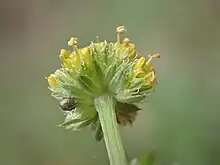| Sanicula hoffmannii | |
|---|---|
 | |
| Scientific classification | |
| Kingdom: | Plantae |
| Clade: | Tracheophytes |
| Clade: | Angiosperms |
| Clade: | Eudicots |
| Clade: | Asterids |
| Order: | Apiales |
| Family: | Apiaceae |
| Genus: | Sanicula |
| Species: | S. hoffmannii |
| Binomial name | |
| Sanicula hoffmannii (Munz) Shan & Constance | |
Sanicula hoffmannii is an uncommon species of flowering plant in the family Apiaceae known by the common names Hoffmann's blacksnakeroot[1] and Hoffmann's sanicle. It is endemic to California, where it is known from the Channel Islands and a few locations in the coastal mountain ranges of the mainland, including the Scott Creek watershed in Santa Cruz County.[2] Its habitat includes coastal hillsides and mountain slopes, sometimes with serpentine soils. It is a perennial herb producing a thick stem up to 90 centimeters tall from a taproot. The green or bluish leaves are compound, the blades each divided into about three lobed, toothed leaflets. The inflorescence is made up of one or more heads of bisexual and male-only flowers with tiny, curving, yellow-green petals.
References
- ↑ USDA, NRCS (n.d.). "Sanicula hoffmannii". The PLANTS Database (plants.usda.gov). Greensboro, North Carolina: National Plant Data Team. Retrieved 30 October 2015.
- ↑ UCSC Arboretum: Scotts Creek
External links
- Calflora Database: Sanicula hoffmannii (Hoffmann's blacksnakeroot, Hoffmann's sanicle)
- Jepson Manual eFlora (TJM2) treatment of Sanicula hoffmannii
- USDA Plants Profile
- U.C. Photos gallery of Sanicula hoffmannii images